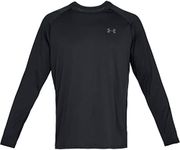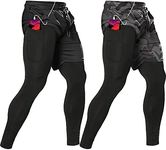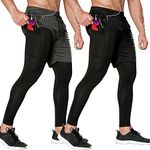Buying Guide for the Best Mens Winter Running Clothes
When it comes to picking the right men's winter running clothes, it's essential to focus on comfort, warmth, and functionality. The right gear can make a significant difference in your running experience, keeping you warm without overheating and ensuring you stay dry and comfortable throughout your run. Here are some key specifications to consider when choosing your winter running clothes.MaterialThe material of your winter running clothes is crucial because it affects warmth, breathability, and moisture-wicking properties. Look for fabrics like merino wool, polyester, or blends that offer a good balance of insulation and breathability. Merino wool is excellent for warmth and moisture management, while synthetic materials like polyester are lightweight and dry quickly. Choose a material that suits your running conditions and personal comfort preferences.
LayeringLayering is important for regulating body temperature during winter runs. Typically, you should have a base layer, a mid-layer, and an outer layer. The base layer should be moisture-wicking to keep sweat away from your skin. The mid-layer provides insulation, and the outer layer should be windproof and water-resistant to protect against the elements. Depending on the weather, you can adjust the number of layers to stay comfortable.
FitThe fit of your running clothes affects both comfort and performance. Clothes that are too tight can restrict movement and cause chafing, while clothes that are too loose may not provide adequate insulation. Look for a snug but comfortable fit that allows for a full range of motion. Consider trying on different sizes and styles to find what works best for your body type and running style.
BreathabilityBreathability is essential to prevent overheating and excessive sweating during your run. Fabrics with good breathability allow moisture and heat to escape, keeping you dry and comfortable. Look for clothes with mesh panels or ventilation features, especially in areas where you tend to sweat the most. This will help regulate your body temperature and improve overall comfort.
InsulationInsulation is key to staying warm during winter runs. The level of insulation you need depends on the temperature and your personal tolerance to cold. Lightweight insulation is suitable for milder winter days, while heavier insulation is better for extremely cold conditions. Consider the type of activity and intensity of your runs when choosing the right level of insulation.
Wind and Water ResistanceWind and water resistance are important for protecting against harsh weather conditions. Windproof fabrics help block cold winds, while water-resistant materials keep you dry in light rain or snow. Look for outer layers with these features to ensure you stay comfortable and protected during your runs. If you often run in wet or windy conditions, prioritize these specifications.
VisibilityVisibility is crucial for safety, especially during early morning or evening runs when it's dark. Look for running clothes with reflective elements or bright colors to increase your visibility to drivers and other runners. This can help prevent accidents and ensure you stay safe while running in low-light conditions.
Comfort FeaturesComfort features such as flat seams, thumbholes, and adjustable hoods can enhance your running experience. Flat seams reduce chafing, thumbholes keep sleeves in place and provide extra warmth, and adjustable hoods offer protection against wind and rain. Consider these additional features based on your personal preferences and the conditions you typically run in.






















